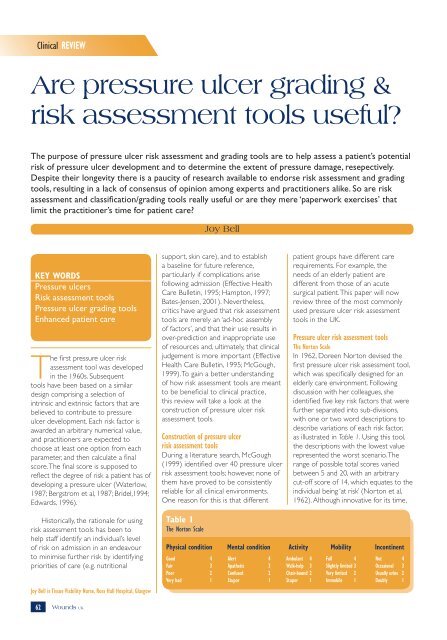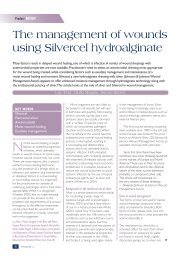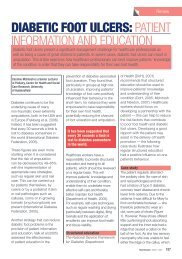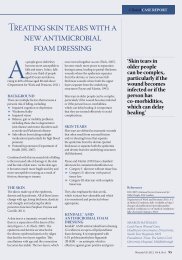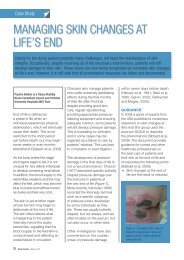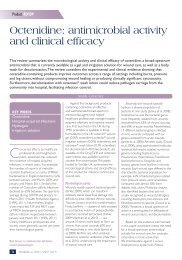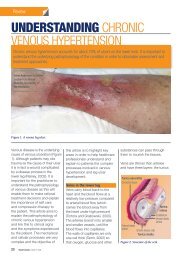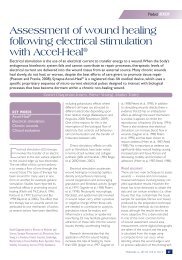Are pressure ulcer grading & risk assessment tools useful?
Are pressure ulcer grading & risk assessment tools useful?
Are pressure ulcer grading & risk assessment tools useful?
You also want an ePaper? Increase the reach of your titles
YUMPU automatically turns print PDFs into web optimized ePapers that Google loves.
Clinical REVIEW<br />
<strong>Are</strong> <strong>pressure</strong> <strong>ulcer</strong> <strong>grading</strong> &<br />
<strong>risk</strong> <strong>assessment</strong> <strong>tools</strong> <strong>useful</strong>?<br />
The purpose of <strong>pressure</strong> <strong>ulcer</strong> <strong>risk</strong> <strong>assessment</strong> and <strong>grading</strong> <strong>tools</strong> are to help assess a patient’s potential<br />
<strong>risk</strong> of <strong>pressure</strong> <strong>ulcer</strong> development and to determine the extent of <strong>pressure</strong> damage, resepectively.<br />
Despite their longevity there is a paucity of research available to endorse <strong>risk</strong> <strong>assessment</strong> and <strong>grading</strong><br />
<strong>tools</strong>, resulting in a lack of consensus of opinion among experts and practitioners alike. So are <strong>risk</strong><br />
<strong>assessment</strong> and classification/<strong>grading</strong> <strong>tools</strong> really <strong>useful</strong> or are they mere ‘paperwork exercises’ that<br />
limit the practitioner’s time for patient care?<br />
Joy Bell<br />
KEY WORDS<br />
Pressure <strong>ulcer</strong>s<br />
Risk <strong>assessment</strong> <strong>tools</strong><br />
Pressure <strong>ulcer</strong> <strong>grading</strong> <strong>tools</strong><br />
Enhanced patient care<br />
The first <strong>pressure</strong> <strong>ulcer</strong> <strong>risk</strong><br />
<strong>assessment</strong> tool was developed<br />
in the 1960s. Subsequent<br />
<strong>tools</strong> have been based on a similar<br />
design comprising a selection of<br />
intrinsic and extrinsic factors that are<br />
believed to contribute to <strong>pressure</strong><br />
<strong>ulcer</strong> development. Each <strong>risk</strong> factor is<br />
awarded an arbitrary numerical value,<br />
and practitioners are expected to<br />
choose at least one option from each<br />
parameter, and then calculate a final<br />
score. The final score is supposed to<br />
reflect the degree of <strong>risk</strong> a patient has of<br />
developing a <strong>pressure</strong> <strong>ulcer</strong> (Waterlow,<br />
1987; Bergstrom et al, 1987; Bridel,1994;<br />
Edwards, 1996).<br />
support, skin care), and to establish<br />
a baseline for future reference,<br />
particularly if complications arise<br />
following admission (Effective Health<br />
Care Bulletin, 1995; Hampton, 1997;<br />
Bates-Jensen, 2001). Nevertheless,<br />
critics have argued that <strong>risk</strong> <strong>assessment</strong><br />
<strong>tools</strong> are merely an ‘ad-hoc assembly<br />
of factors’, and that their use results in<br />
over-prediction and inappropriate use<br />
of resources and, ultimately, that clinical<br />
judgement is more important (Effective<br />
Health Care Bulletin, 1995; McGough,<br />
1999). To gain a better understanding<br />
of how <strong>risk</strong> <strong>assessment</strong> <strong>tools</strong> are meant<br />
to be beneficial to clinical practice,<br />
this review will take a look at the<br />
construction of <strong>pressure</strong> <strong>ulcer</strong> <strong>risk</strong><br />
<strong>assessment</strong> <strong>tools</strong>.<br />
Construction of <strong>pressure</strong> <strong>ulcer</strong><br />
<strong>risk</strong> <strong>assessment</strong> <strong>tools</strong><br />
During a literature search, McGough<br />
(1999) identified over 40 <strong>pressure</strong> <strong>ulcer</strong><br />
<strong>risk</strong> <strong>assessment</strong> <strong>tools</strong>; however, none of<br />
them have proved to be consistently<br />
reliable for all clinical environments.<br />
One reason for this is that different<br />
patient groups have different care<br />
requirements. For example, the<br />
needs of an elderly patient are<br />
different from those of an acute<br />
surgical patient. This paper will now<br />
review three of the most commonly<br />
used <strong>pressure</strong> <strong>ulcer</strong> <strong>risk</strong> <strong>assessment</strong><br />
<strong>tools</strong> in the UK.<br />
Pressure <strong>ulcer</strong> <strong>risk</strong> <strong>assessment</strong> <strong>tools</strong><br />
The Norton Scale<br />
In 1962, Doreen Norton devised the<br />
first <strong>pressure</strong> <strong>ulcer</strong> <strong>risk</strong> <strong>assessment</strong> tool,<br />
which was specifically designed for an<br />
elderly care environment. Following<br />
discussion with her colleagues, she<br />
identified five key <strong>risk</strong> factors that were<br />
further separated into sub-divisions,<br />
with one or two word descriptions to<br />
describe variations of each <strong>risk</strong> factor,<br />
as illustrated in Table 1. Using this tool,<br />
the descriptions with the lowest value<br />
represented the worst scenario. The<br />
range of possible total scores varied<br />
between 5 and 20, with an arbitrary<br />
cut-off score of 14, which equates to the<br />
individual being ‘at <strong>risk</strong>’ (Norton et al,<br />
1962). Although innovative for its time,<br />
Historically, the rationale for using<br />
<strong>risk</strong> <strong>assessment</strong> <strong>tools</strong> has been to<br />
help staff identify an individual’s level<br />
of <strong>risk</strong> on admission in an endeavour<br />
to minimise further <strong>risk</strong> by identifying<br />
priorities of care (e.g. nutritional<br />
Joy Bell is Tissue Viability Nurse, Ross Hall Hospital, Glasgow<br />
Table 1<br />
The Norton Scale<br />
Physical condition Mental condition Activity Mobility Incontinent<br />
Good 4 Alert 4 Ambulant 4 Full 4 Not 4<br />
Fair 3 Apathetic 3 Walk-help 3 Slightly limited 3 Occasional 3<br />
Poor 2 Confused 2 Chair-bound 2 Very limited 2 Usually urine 2<br />
Very bad 1 Stupor 1 Stupor 1 Immobile 1 Doubly 1<br />
62 Wounds UK
Clinical REVIEW<br />
Table 2<br />
Predictive validity of <strong>risk</strong> <strong>assessment</strong> scales<br />
Scale Author Sensitivity Specificity<br />
Braden Bergstrom et al, 1992 (short stay)<br />
Bergstrom et al, 1992 (ICU)<br />
Braden et al, 1994 (nursing home)<br />
Langemo et al, 1991 (orthopaedic)<br />
Barnes et al, 1993 (cardiothoracic)<br />
100%<br />
83%<br />
46%<br />
64%<br />
73%<br />
90%<br />
90%<br />
88%<br />
87%<br />
91%<br />
Waterlow Smith, 1989 73% 38%<br />
Norton Norton et al, 1962 (elderly care)<br />
Goldstone et al, 1982 (orthopaedic)<br />
Smith, 1989 (orthopaedic)<br />
63%<br />
89%<br />
50%<br />
70%<br />
36%<br />
31%<br />
the Norton scale has little research to<br />
endorse its use outside of an elderly<br />
care setting. Furthermore, subsequent<br />
modified versions of this tool have<br />
incorporated nutrition as a <strong>risk</strong> factor,<br />
highlighting recent research alluding to<br />
the importance of nutrition and wound<br />
healing, and have also stratified the<br />
degrees of <strong>risk</strong> (Wai-Han et al, 1997;<br />
NMPDU, 2002; EPUAP, 2003).<br />
The Braden Scale<br />
The Braden Scale was devised by<br />
American researchers in the mid-1980s.<br />
Following an extensive literature search,<br />
the foundation for this tool was based<br />
on a ‘conceptual schema of aetiological<br />
factors’ whereby ‘<strong>pressure</strong>’ and ‘tissue<br />
tolerance’ were identified as significant<br />
factors in <strong>pressure</strong> <strong>ulcer</strong> development.<br />
Six further parameters were identified<br />
as <strong>risk</strong> factors that could contribute to<br />
<strong>pressure</strong> or affect the tissue tolerance<br />
of the skin. The range of possible total<br />
scores when using this tool varies<br />
between 6 and 23 and, like the Norton<br />
scale, low scores signify higher <strong>risk</strong>.<br />
The cut off points that signify that an<br />
individual is ‘at <strong>risk</strong>’ varies between<br />
16 and 18, depending on the clinical<br />
environment in which the tool is being<br />
used (Bergstrom et al,1987).<br />
One criticism of this tool is the inability<br />
of staff to distinguish what is meant by<br />
some of the parameters. An example<br />
of this is the use of <strong>risk</strong> factors, such<br />
as ‘mobility and activity’, whereby<br />
the authors use the term ‘mobility’<br />
to question if the patient is able to<br />
relieve <strong>pressure</strong> through movement?<br />
Whereas, the ‘activity’ parameter relates<br />
to the frequency and duration of a<br />
patient’s movement. So, in actual fact,<br />
the terms mean different things but<br />
further clarification or education may be<br />
required at ward level. Unlike the other<br />
<strong>pressure</strong> <strong>ulcer</strong> <strong>risk</strong> <strong>assessment</strong> <strong>tools</strong>, the<br />
Braden scale has been widely researched<br />
within different clinical environments,<br />
as illustrated in Table 2. However, it is<br />
evident that the predictive validity of<br />
the Braden scale is not consistently high<br />
for all clinical areas (Capobianco and<br />
McDonald, 1996).<br />
The Waterlow Scale<br />
In 1987, Judy Waterlow devised the<br />
Waterlow scale following an extensive<br />
literature search and pilot studies within<br />
her local areas. She felt that the Norton<br />
scale did not address nutritional issues,<br />
account for underlying pathology, or<br />
highlight the <strong>risk</strong> of patients undergoing<br />
surgical procedures. In comparison<br />
to the Norton and Braden scale, the<br />
Waterlow scale identifies significantly<br />
more <strong>risk</strong> factors in the <strong>assessment</strong><br />
tool, resulting in a possible total score<br />
ranging between 4 and 40. High scores<br />
signify high <strong>risk</strong> (10+ = at <strong>risk</strong>; 15+ =<br />
high <strong>risk</strong>; 20+ = very high <strong>risk</strong>). Judy<br />
Waterlow also went to considerable<br />
effort to ensure that her tool was<br />
user friendly and, by incorporating<br />
information on methods of how to<br />
prevent <strong>pressure</strong> <strong>ulcer</strong> development,<br />
she encouraged staff to be proactive<br />
in the prevention and management<br />
of <strong>pressure</strong> <strong>ulcer</strong>s (Waterlow, 1988;<br />
Waterlow, 1998). However, despite its<br />
wide use within the UK, the Waterlow<br />
scale has been criticised for its lack<br />
of research and its ability to overpredict<br />
and, consequently, result in the<br />
misuse of resources (Edwards,1995;<br />
McGough,1999).<br />
More recently, Judy Waterlow has<br />
revised her original version of the<br />
Waterlow scale following collaboration<br />
with colleagues in Australia. She has<br />
made a few amendments as listed in<br />
Table 3 (Waterlow, 2005). In addition,<br />
she has produced a manual to clarify<br />
many of the ‘grey areas’ that arose<br />
from use of the original tool. However,<br />
once again, research is eagerly awaited<br />
to assess the revised Waterlow scale’s<br />
effectiveness in clinical practice.<br />
Which <strong>risk</strong> <strong>assessment</strong> tool is the best?<br />
The simple answer is that there is no<br />
‘best’ <strong>pressure</strong> <strong>ulcer</strong> <strong>risk</strong> <strong>assessment</strong><br />
tool. Experts have been unable to<br />
unequivocally endorse one specific<br />
tool for all clinical areas, due to a lack<br />
of robust research (EPUAP, 1998;<br />
RCN, 2000; NMPDU, 2002). So how<br />
can we decide which tool is the most<br />
appropriate for our clinical area? It is<br />
important to consider the predictive<br />
validity of a tool when either piloting <strong>risk</strong><br />
<strong>assessment</strong> <strong>tools</strong> within a clinical area,<br />
or when reviewing the literature. The<br />
predictive validity assesses the efficacy<br />
of a tool at differentiating between<br />
individuals who are at <strong>risk</strong> and those<br />
who are not, and this is achieved by<br />
measuring the sensitivity and specificity<br />
of a tool.<br />
The sensitivity looks at the accuracy<br />
of the tool in predicting those who<br />
will develop the condition; the ideal<br />
tool would achieve a score of 100%.<br />
Similarly, specificity aims to ascertain<br />
a tool’s ability at predicting those who<br />
will not develop a <strong>pressure</strong> <strong>ulcer</strong>, thus<br />
avoiding over prediction and a waste<br />
of resources. Once again, the ideal<br />
score for specificity would be 100%.<br />
Another factor to consider when<br />
looking at the research is inter-rater<br />
reliability, to ensure that different levels<br />
of staff can use the tool and achieve<br />
a similar outcome, thereby minimising<br />
the <strong>risk</strong> of huge discrepancies arising.<br />
Finally, when reviewing the literature,<br />
it is important to acknowledge the<br />
methodology of the study and to<br />
consider who has been involved in the<br />
88 64 Wounds UK
Clinical REVIEW<br />
Table 3<br />
Amendments to the Waterlow scale<br />
Risk factor Amendment in revised Waterlow<br />
Build/weight for BMI score incorporated into this section<br />
height<br />
Continence<br />
Diferentiates between urinary and faecal incontinence<br />
Skin type visual Defines ‘discolouration’ and ‘broken spots’ using the EPUAP classification tool<br />
<strong>risk</strong> areas<br />
Mobility<br />
Defines the terms ‘bed-bound’ and ‘chair-bound’<br />
Appetite<br />
This has been replaced with a Malnutrition Screening Tool to identify nutritional<br />
status. (An Australian screening tool, rather than the MUST screening tool<br />
produced by BAPEN is used)<br />
Tissue malnutrition Clarifies single and multiple organ failure, and defines what constitutes anaemia<br />
Neurological deficit Limits the score for this parameter to 6<br />
Major surgery/trauma Incorporates a score for operations longer than 6 hours. Explains that this<br />
score can be discontinued 48 hours post-operatively if the individual is making<br />
a normal recovery<br />
Medication Limits the score for this parameter to 4<br />
data collection process, as there may be<br />
an unintentional element of researcher<br />
bias (Edwards, 1996).<br />
Guidance when using <strong>risk</strong> <strong>assessment</strong> <strong>tools</strong><br />
Despite the lack of research to endorse<br />
<strong>risk</strong> <strong>assessment</strong> <strong>tools</strong>, the guidance<br />
produced by the experts still advocates<br />
their use in clinical practice, although<br />
in conjunction with clinical judgement.<br />
Nevertheless, they also emphasise<br />
that <strong>risk</strong> <strong>assessment</strong> <strong>tools</strong> should be<br />
appropriate for the clinical environment<br />
in which they are being used. In addition,<br />
staff should receive adequate training<br />
to ensure that they are competent to<br />
use the <strong>pressure</strong> <strong>ulcer</strong> <strong>risk</strong> <strong>assessment</strong><br />
<strong>tools</strong>. This is especially relevant for<br />
novice practitioners, who do not have<br />
the extensive clinical judgement skills<br />
that experienced practitioners have.<br />
Therefore, <strong>risk</strong> <strong>assessment</strong> <strong>tools</strong> may<br />
be beneficial for them, particularly<br />
when admitting patients, in order to<br />
help prioritise care until they are more<br />
familiar with their patient (EPUAP, 1998;<br />
RCN, 2000; NMPDU, 2002).<br />
Finally, it is important to realise that<br />
because <strong>pressure</strong> <strong>ulcer</strong> <strong>risk</strong> <strong>assessment</strong><br />
scores are part of the nursing<br />
documentation and therefore a legal<br />
document, they must be completed<br />
properly as they may be reviewed at<br />
a later date if a case of litigation arises<br />
(Dimond, 1994). This paper will now<br />
look at the merit of some of the<br />
commonly used <strong>pressure</strong> <strong>ulcer</strong> <strong>grading</strong>/<br />
classification <strong>tools</strong>.<br />
Pressure <strong>ulcer</strong> <strong>grading</strong>/classification <strong>tools</strong><br />
In 1993, the Department of Health<br />
published a report on <strong>pressure</strong><br />
<strong>ulcer</strong>s, A Key Quality Indicator of Care,<br />
wherein it was suggested that an<br />
effort should be made to reduce the<br />
number of <strong>pressure</strong> <strong>ulcer</strong>s nationally.<br />
It was suggested that the number of<br />
<strong>pressure</strong> <strong>ulcer</strong>s would be identified<br />
through prevalence/incidence studies<br />
(DoH, 1993). However, to determine<br />
the extent of <strong>pressure</strong> <strong>ulcer</strong> damage<br />
at an individual level, a <strong>pressure</strong> <strong>ulcer</strong><br />
classification/<strong>grading</strong> tool is required.<br />
Historically, it has been very difficult<br />
to compare and analyse national/<br />
international data obtained from<br />
prevalence and incidence studies and,<br />
thus, to ascertain if the <strong>pressure</strong> <strong>ulcer</strong><br />
problem is increasing or decreasing.<br />
Different <strong>pressure</strong> <strong>ulcer</strong> classification/<br />
<strong>grading</strong> <strong>tools</strong> are used throughout the<br />
country, and the grades within different<br />
<strong>tools</strong> can equate to different levels of<br />
<strong>pressure</strong> damage. One example of this<br />
is that a grade 1 using the Torrance<br />
scale equates to blanching hyperaemia;<br />
conversely, a grade 1 using the EPUAP<br />
tool means that the patient has nonblanching<br />
erythema and, therefore, the<br />
data is incomparable (Sharp, 2004).<br />
Like <strong>pressure</strong> <strong>ulcer</strong> <strong>risk</strong> <strong>assessment</strong><br />
<strong>tools</strong>, <strong>pressure</strong> <strong>ulcer</strong> classification/<strong>grading</strong><br />
<strong>tools</strong> are, generally, numerical systems<br />
that are used to describe the depth<br />
of a <strong>pressure</strong> <strong>ulcer</strong> by illustrating the<br />
amount of tissue loss in relation to the<br />
anatomy of the intact skin (Shea, 1975).<br />
Shea, an orthopaedic surgeon, devised<br />
the first classification tool in the mid-<br />
1970s based on an anatomical model,<br />
and subsequent researchers adopted a<br />
similar approach to describe the extent<br />
of tissue loss. This paper shall now<br />
compare the three most commonly<br />
used <strong>pressure</strong> <strong>ulcer</strong> classification/<strong>grading</strong><br />
<strong>tools</strong> within the UK.<br />
Torrance classification system<br />
This <strong>pressure</strong> <strong>ulcer</strong> classification tool<br />
was devised in 1983 and has five<br />
subsections or stages (Torrance, 1983).<br />
The major criticism of this tool is that<br />
it describes a grade 1 <strong>pressure</strong> <strong>ulcer</strong><br />
as ‘blanching hyperaemia’. Critics have<br />
disputed that blanching hyperaemia<br />
represents a warning sign and thus an<br />
underlying physiological reaction to<br />
<strong>pressure</strong>, rather than actual <strong>pressure</strong><br />
damage. Furthermore, the term<br />
hyperaemia is often used synonymously<br />
with erythema but the terms mean<br />
different things (Bliss,1998; Bethell,<br />
2003; Sharp, 2004).<br />
Stirling Pressure Sore Severity Scale (SPSSS)<br />
The SPSSS tool was developed in 1984<br />
by Reid and Morrison at a consensus<br />
meeting (Reid and Morrison, 1994).<br />
Essentially, this tool describes four<br />
levels of <strong>pressure</strong> damage with grade<br />
one described as ‘non-blanching<br />
erythema’. This tool has several levels<br />
of descriptors within each grade;<br />
however, there is mixed opinion as<br />
to whether the descriptors assist or<br />
confuse practitioners when using this<br />
tool to assess the level of <strong>pressure</strong><br />
damage. Certainly, the authors’ rationale<br />
for including the extensive descriptors<br />
was to help make thing easier for<br />
practitioners. Another major criticism<br />
is that the tool suggests a grade for<br />
an <strong>ulcer</strong> that is covered with eschar.<br />
This is certainly a contentious issue as<br />
many experts argue that eschar masks<br />
the depth of underlying damage, hence<br />
making it impossible to grade the level<br />
of harm (Sharp, 2004).<br />
66 Wounds UK
Clinical REVIEW<br />
Key Points<br />
8 Currently there is no superior<br />
alternative to the <strong>risk</strong><br />
<strong>assessment</strong> and classification/<br />
<strong>grading</strong> <strong>tools</strong> that are widely<br />
used in clincial practice.<br />
8 Despite a paucity of research<br />
available to endorse them, both<br />
<strong>tools</strong> are still recommended<br />
for use during the <strong>assessment</strong><br />
process.<br />
8 If used appropriately, both <strong>tools</strong><br />
have the potential to enhance<br />
patient care.<br />
European Pressure Ulcer Advisory Panel<br />
(EPUAP) <strong>grading</strong> tool<br />
The experts who constitute the EPUAP<br />
have now reached a consensus of<br />
opinion and recommend the use of the<br />
EPUAP Guide to Pressure Ulcer Grading<br />
(EPUAP, 2003). This tool is a modified<br />
version of the National Pressure Ulcer<br />
Advisory Panel (NPUAP) classification<br />
tool, in which some of the descriptions<br />
have been altered, and where stages<br />
have been re-named as grades. Like<br />
the SPSSS scale, the EPUAP <strong>grading</strong><br />
tool has four grades with non-blanching<br />
erythema regarded as a grade 1<br />
<strong>pressure</strong> <strong>ulcer</strong>. Furthermore, the<br />
EPUAP <strong>grading</strong> tool also describes some<br />
warning signs that may be evident in an<br />
individual with pigmented skin, which<br />
has not previously been addressed.<br />
What is the best <strong>grading</strong>/classification tool?<br />
Like <strong>pressure</strong> <strong>ulcer</strong> <strong>risk</strong> <strong>assessment</strong> <strong>tools</strong>,<br />
there is a dearth of research available<br />
to endorse one particular classification<br />
tool, although the EPUAP do now<br />
recommend the use of the EPUAP<br />
Guide to Pressure Ulcer Grading Tool<br />
(EPUAP, 2003). Unlike <strong>pressure</strong> <strong>ulcer</strong> <strong>risk</strong><br />
<strong>assessment</strong> <strong>tools</strong>, where the predictive<br />
validity was an important factor when<br />
reviewing the research, it is more<br />
important to assess inter-rater reliability<br />
with classification/<strong>grading</strong> <strong>tools</strong>. This<br />
is because classification/<strong>grading</strong> <strong>tools</strong><br />
are constructed in a similar manner,<br />
therefore, it is important to establish<br />
that when different practitioners use the<br />
tool to assess a wound, that they will<br />
reach a similar conclusion.<br />
There are three main pieces of<br />
research assessing inter-rater reliability<br />
of <strong>pressure</strong> <strong>ulcer</strong> classification/<strong>grading</strong><br />
<strong>tools</strong>. The method of investigation in<br />
each of the studies relied on either the<br />
use of photographs, or visual inspection<br />
of skin, to test the practitioner’s ability<br />
to grade <strong>ulcer</strong>s accurately. In 1996,<br />
Healey found that the increased<br />
descriptions within the Stirling (SPSSS)<br />
tool had the reverse effect than what<br />
the authors had anticipated, and actually<br />
reduced the levels of agreement<br />
between staff. Bours et al (1999)<br />
noted that there was a higher level of<br />
agreement when practitioners had the<br />
opportunity to discuss EPUAP <strong>grading</strong><br />
as a group, in comparison to scoring<br />
<strong>pressure</strong> <strong>ulcer</strong>s independently. Defloor<br />
and Schoonhoven (2004) suggested<br />
that there was a high level of inter-rater<br />
reliability among experts when using<br />
the EPUAP classification tool. However,<br />
there was difficulty in distinguishing<br />
between incontinence lesions, blisters<br />
and superficial <strong>pressure</strong> <strong>ulcer</strong>s.<br />
All of the studies above used the<br />
Kappa’s co-efficient statistical test to<br />
analyse their results. However, critics<br />
have intimated that the Kappa’s<br />
statistical test may not be the most<br />
reliable, raising questions about the<br />
results of these studies (Defloor and<br />
Schoonhoven, 2004). Would another<br />
statistical test show the results of these<br />
studies in a more or less favourable<br />
light? Once again, to answer this<br />
question, further research is required to<br />
establish a true picture of the efficacy of<br />
these classification <strong>tools</strong>.<br />
Guidance when using classification <strong>tools</strong><br />
Like <strong>risk</strong> <strong>assessment</strong> <strong>tools</strong>, <strong>pressure</strong> <strong>ulcer</strong><br />
classification/<strong>grading</strong> <strong>tools</strong> are regarded<br />
as important implements to help grade<br />
the extent of <strong>pressure</strong> damage and<br />
form an integral part of the nursing<br />
documentation and wound <strong>assessment</strong>.<br />
However, for the <strong>assessment</strong> to be<br />
accurate, practitioners need be educated<br />
on how to use the <strong>tools</strong>. Looking at the<br />
larger picture, it would be beneficial if<br />
one tool was adopted at a national level<br />
to ascertain if the incidence and grade of<br />
<strong>pressure</strong> <strong>ulcer</strong>s is increasing or decreasing<br />
(EPUAP, 1998). Finally, it is important that<br />
<strong>pressure</strong> <strong>ulcer</strong> classification/<strong>grading</strong> <strong>tools</strong><br />
are not used by practitioners to reverse<br />
grade healing <strong>ulcer</strong>s, because wound<br />
healing is not simply the reverse sequence<br />
of repairing tissue that ensued from<br />
<strong>pressure</strong> <strong>ulcer</strong>ation (Clark, 2005).<br />
Conclusion<br />
Currently there is no superior alternative<br />
to the <strong>pressure</strong> <strong>ulcer</strong> <strong>risk</strong> <strong>assessment</strong> and<br />
classification/<strong>grading</strong> <strong>tools</strong> that are widely<br />
used in clinical practice. Despite a lack<br />
of consistent robust research, both <strong>tools</strong><br />
are still recommended for use during the<br />
<strong>assessment</strong> process. Essentially, if used<br />
appropriately, both types of tool have the<br />
potential to enhance patient care, through<br />
early implementation of preventative or<br />
management strategies, to prevent or<br />
minimise further <strong>pressure</strong> damage. WUK<br />
References<br />
Barnes D, Payton RG (1993) Clinical<br />
Application of the Braden Scale in the Acutecare<br />
Setting. Dermatol Nurs 5(5): 386–8<br />
Bates-Jensen B (2001) Quality indicators for<br />
prevention and management of <strong>pressure</strong> <strong>ulcer</strong>s<br />
in vulnerable elders. Ann Intern Med 135(8):<br />
744–50<br />
Bergstrom N, Braden BJ, Laguzza A, Holman<br />
V (1987) The Braden Scale for Predicting<br />
Pressure Sore Risk. Nurs Res 36(4): 205–210<br />
Bergstrom N, Demuth PJ, Braden BJ (1987) A<br />
Clinical trial of the Braden Scale for Predicting<br />
Pressure Sore Risk. Nurs Clin N Am 22(2): 417–28<br />
Best Practice Statement (2002) Pressure Ulcer<br />
Prevention (2002). Available from: www.<br />
nhshealthquality.org<br />
Best Practice Statement (2002) Nutrition:<br />
<strong>assessment</strong> and referral in the care of adults in<br />
hospital. Available from: www.nhshealthquality.org<br />
Bethell E (2003) Controversies in classifying<br />
and assessing grade 1 <strong>pressure</strong> <strong>ulcer</strong>s. J Wound<br />
Care 12(1): 33–6<br />
Bliss MR (1998) Hyperaemia. J Tissue Viability<br />
8(4): 4–13<br />
Bours GJ, Halfens RJ, Lubbers M, Haalboom<br />
JR (1999) The development of a national<br />
registration form to measure the prevalence<br />
of <strong>pressure</strong> <strong>ulcer</strong>s in the Netherlands. Ostomy/<br />
Wound Management 45: 28–40<br />
Braden BJ, Bergstrom N (1994) Predictive<br />
Validity of the Braden Scale for <strong>pressure</strong> sore <strong>risk</strong><br />
in a nursing home. Res Nurs Health 17: 459–70<br />
Bridel J (1994) Risk <strong>assessment</strong>. J Tissue<br />
Viability 4(3): 84–5<br />
68 Wounds UK
Clinical REVIEW<br />
Capobianco ML, McDonald DP (1996) Factors<br />
affecting the predictive validity of the Braden<br />
Scale. Adv Wound Care 9(6): 32–6<br />
Clark M (2005) What drives <strong>pressure</strong> <strong>ulcer</strong><br />
classification — scientific knowledge or fear of<br />
litigation? J Tissue Viability 15(2): 2–4<br />
Defloor T, Schoonhoven L (2004) Interrater<br />
reliability of the EPUAP <strong>pressure</strong> <strong>ulcer</strong><br />
classification system using photographs. J Clin<br />
Nurs 13: 952–9<br />
Department of Health (1993) Pressure sores a<br />
key quality indicator. HMSO, London<br />
Dimond B (1994) Pressure Sores: a case to<br />
answer. Br J Nurs 3(14): 721–7<br />
Edwards M (1995) The levels of reliability and<br />
validity of the Waterlow <strong>pressure</strong> sore <strong>risk</strong><br />
calculator. J Wound Care 4(8): 373–8<br />
Edwards M (1996) Pressure sore <strong>risk</strong><br />
calculators: some methodological issues. J Clin<br />
Nurs 5: 307–12<br />
EHCB (1995) The Prevention and Treatment<br />
of Pressure Ulcers. Effective Health Care Bulletin<br />
Churchill Livingstone, London<br />
European Pressure Ulcer Advisory Panel<br />
(2003) The EPUAP Guide to Pressure Ulcer<br />
Grading. Available from: http://www.epuap.<br />
org/<strong>grading</strong>.html<br />
Hampton S (1997) Preventable <strong>pressure</strong> sores.<br />
Care Crit Ill 13(5): 193–7<br />
Healey F (1996) The reliability and utility of<br />
<strong>pressure</strong> sore <strong>grading</strong> scales. J Tissue Viability<br />
5: 111–14<br />
Kappa Coefficients. Available from: http://<br />
www.ourworld.compuserve.com/homepages/<br />
jsuebersax/kappa.htm<br />
Langemo DK, OlsonB, Hunter S, Hanson<br />
D, Burd C, Cathcart-Silberberg T (1991)<br />
Incidence and prediction of <strong>pressure</strong> <strong>ulcer</strong>s in<br />
patient care settings. Decubitus: 25–36<br />
McGough AJ (1999) A Systematic Review of the<br />
Effectiveness of Risk Assessment Scales Used in<br />
the Prevention and Management of Pressure Sores.<br />
MSc Thesis, University of York<br />
Norton D, McLaren R, Exton-Smith AN (1962)<br />
An Investigation of Geriatric Nursing Problems in<br />
Hospital. National Corporation for the Care of<br />
Old People, London<br />
Pieper B, Sugrue M, Weiland M, Sprague K,<br />
Heiman C (1998) Risk factors, prevention<br />
methods and wound care for patients with<br />
<strong>pressure</strong> <strong>ulcer</strong>s. Clin Nurse Specialist 12(1):<br />
7–12<br />
Reid K, Morrison M (1994) Towards a<br />
consensus: classification of <strong>pressure</strong> <strong>ulcer</strong>s. J<br />
Wound Care 3(3): 157–60<br />
Royal College of Nursing (2000) Pressure<br />
Ulcer Risk Assessment and Prevention:<br />
Recommendations. RCN, London. Available<br />
from: www.rcn.org.uk<br />
Scott EM (2000) The prevention of <strong>pressure</strong><br />
<strong>ulcer</strong>s through <strong>risk</strong> <strong>assessment</strong>. J Wound Care<br />
9(2): 69–70<br />
Sharp A (2004) Pressure <strong>ulcer</strong> <strong>grading</strong> <strong>tools</strong><br />
how reliable are they? J Wound Care 13(2): 75–8<br />
Shea JD (1975) Pressure <strong>ulcer</strong>s: classification<br />
and management. Clin Orthop 112: 89–100<br />
Torrance C (1983) Pressure Sores, Aetiology,<br />
Treatment and Prevention. Groom Helm, London<br />
Wai-Han C, Kit-Wai C, French P, Yim-Sheung<br />
L, Lai-Kwan T (1997) Which <strong>pressure</strong> sore<br />
<strong>risk</strong> calculator? A study of the effectiveness of<br />
the Norton Scale in Hong Kong. Int J Nurs Stud<br />
34(2): 165–9<br />
Waterlow J (1987) Calculating the <strong>risk</strong>. Nurs<br />
Times 83(39): 58–60<br />
Waterlow J (1988) The Waterlow Card for the<br />
prevention and management of <strong>pressure</strong> sores:<br />
towards a pocket policy. Care Science Practice<br />
6(1): 8–12<br />
Waterlow J (1998) The history and use of the<br />
Waterlow Card. Nurs Times 94(7): 63–9<br />
Waterlow J (2005) Pressure Ulcer Prevention<br />
Manual: www.judy_waterlow.co.uk<br />
Wellard S, Lo SK (2000) Comparing Norton,<br />
Braden and Waterlow Risk Assessment Scales<br />
for <strong>pressure</strong> <strong>ulcer</strong>s in spinal cord injuries.<br />
Contemp Nurse 9(2): 155–60<br />
Wounds UK<br />
69


